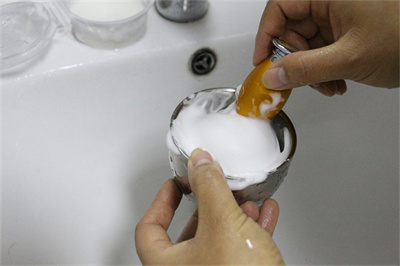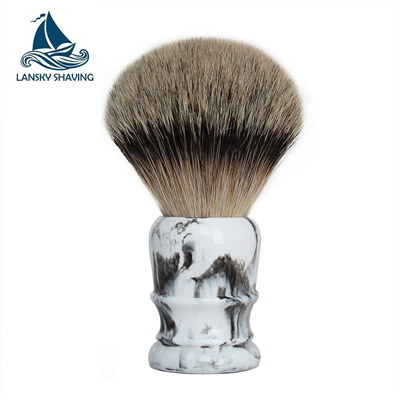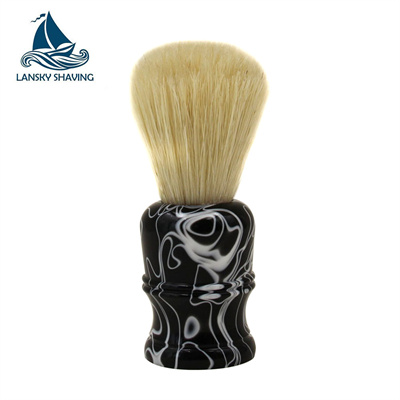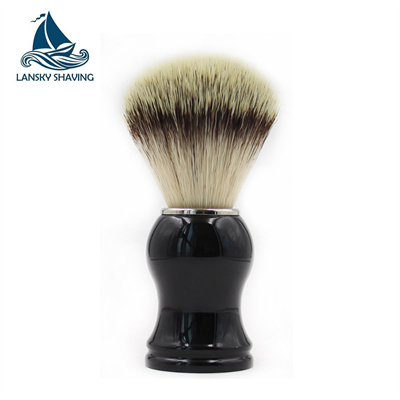
2023-11-07 16:50:18
Shaving brushes have been a part of men's grooming routines for centuries. The earliest forms of shaving brushes were made from animal hair and were used by wealthy men in the 18th century. Today, shaving brushes come in many shapes, sizes, and materials, and are an essential tool for achieving a close and comfortable shave.
In this guide, we'll cover the different qualities that you can expect from shaving brushes at various price points. By understanding the features that distinguish cheap and expensive brushes, you can make an informed decision when choosing the right brush for your needs.

When it comes to the bristles of a shaving brush, there are several different materials to choose from. The most common materials used for shaving brush bristles are badger hair, boar hair, horsehair, and synthetic fibers.

Badger hair is considered by many to be the best material for shaving brush bristles. It is soft, water-retentive, and can create a rich lather. There are different grades of badger hair, with the highest quality being "Silvertip" badger hair. Silvertip badger hair is the most expensive and is characterized by its silvery-white tips. Badger hair comes in four grades: pure, best, super, and silver tip. Cheaper brushes made from pure badger hair can be found for under $10, while more expensive brushes made from higher grades of badger hair can cost anywhere from $50 to $200 or more. The price depends on the grade of badger hair used and other factors.

Boar hair is another popular material for shaving brush bristles. Boar hair is coarser than badger hair, but it is still soft and can create a good lather. Boar hair brushes are also less expensive than badger hair brushes, making them a good option for those on a budget. There are different grades of bristles that can affect the price and quality of the brush. Cheap models can be found for just a couple of dollars, with decently-functional models starting around $10 and higher-quality models costing around $20 to $30.
Horse hair brushes are less common than badger hair and boar hair brushes, but they can still be a good choice for those looking for a more eco-friendly option. Horsehair brushes are made from the mane or tail hair of horses and are usually softer than boar hair brushes but not as soft as badger hair brushes. Horsehair brushes are another option, with prices ranging from around $2 for cheap models to $20 to $40 for more expensive ones.

Synthetic fiber brushes are a popular choice among those with allergies or ethical concerns about using animal products. Synthetic fiber brushes can be made to simulate the feel and performance of natural hair, and they are usually less expensive than natural hair brushes. Synthetic fiber brushes are also easier to maintain and clean than natural hair brushes. Price is a key factor here, with cheap, thick nylon brushes available for as little as $1, while more expensive, synthetic models can retail anywhere from $40 to $140.
Shaving brush handles are available in a wide variety of materials including bone, ivory, metal, horn, wood, ceramic, resin, and plastic. The cost of the handle material is a significant factor in determining the price of a brush. However, the handle is primarily a decorative choice as a brush with an expensive handle is likely to offer the same shaving experience as a brush with a cheaper handle, provided both have good-quality bristles.
There are various factors that set expensive shaving brush handles apart from cheaper ones. Low-cost handles are often made from cheap materials like hollow plastic that can crack more easily, which means you'll need to replace them more frequently. They might also have generic, knobby grips that feel awkward in the hand or have boring or tacky designs that aren't very appealing. In contrast, expensive handles have finer details, elegant lines, and are made of exquisite materials that make them a pleasure to hold and behold. They are also more likely to have an ergonomic grip, making them easier to use.
The construction of the brush is also an important consideration, with the knot or the finished head of the bristles being the most critical component. Knot assembly refers to how the knot is put together, and there are two main methods: knotting and gluing. Knotting involves knotting bunches of bristles together in groupings that form the knot. This approach ensures that all the bristles stay firmly together in the knot, making it less likely to come loose. Also, knotted brushes retain their shape throughout years of shaving. Gluing, on the other hand, involves either partially knotting or gluing together groups of bristles, which are then glued together to form the total head. Glued knots can start coming apart after even just a few months of use, especially in high humidity environments like bathrooms.
The quality of the construction of a shaving brush can also affect the quality of your shave. Expensive shaving brushes are more likely to have knots of variable length called "loft" and come in various shapes like a bulb, fan, flat, or hybrids of these. Knot shapes affect the feel, distribution, and application of lather, depending on your own personal shaving style and technique. Therefore, they’re a detail that depends largely on personal preference, but they can still impact the quality of your shave.
Finally, the construction of a shaving brush also includes how the knot is attached to the handle. Cheaper brushes are often assembled using glue, which can cause the knot to come apart from the handle over time due to exposure to humidity and other environmental factors. This can be frustrating and require replacement of the brush. In contrast, more expensive brushes will typically feature a more secure attachment method such as being screwed, bolted, or pegged into place. This ensures a more durable and long-lasting brush that will remain in good condition for many years of use. Investing in a brush with a secure knot attachment can save you money in the long run by reducing the need for frequent replacements.
In conclusion, understanding the qualities that distinguish between cheap and expensive shaving brushes can help you make an informed decision when choosing the right brush for your needs. Factors to consider include the type and quality of the bristles, the material and construction of the handle, and the method of knot attachment. Investing in a high-quality shaving brush can enhance the overall shaving experience and provide a closer shave.
When selecting a shaving brush, it is essential to look for hallmarks of quality, such as the use of premium materials, ergonomic design, and a secure knot attachment. By paying attention to these details, you can ensure that you get a quality brush that will not only provide a better shave but also last for years to come.
We would love to hear from you in the comments below! What qualities do you look for in a shaving brush, and have you had any particularly good or bad experiences with different types of brushes?
>>Previous: The Quintessential Badger Shaving Brush
>>Next: How to Choose a Shaving Brush?
Home| Products|Brush Guide|News|About Us|Contact Us| Sitemap
E-mail: brush@lanskyco.com Tel: +86-311-8777 7060/ +86-311-8520 9228 Fax: +86-311-8520 9229
Copyright © Shijiazhuang Lansky Trade Co.,Ltd. All Rights Reserved. Technical Support: Reanod